‘The Hunchback of Notre Dame’ at 25 – Review
The Hunchback of Notre Dame (1996)
Directors: Gary Trousdale, Kirk Wise
Screenwriters: Tab Murphy, Irene Mecchi, Bob Tzudiker, Noni White, Jonathan Roberts
Starring: Tom Hulce, Demi Moore, Tony Jay, Kevin Kline, Paul Kandel, Jason Alexander, Charles Kimbrough, Mary Wickes, David Ogden Stiers
There have been numerous adaptations of Victor Hugo’s “Notre-Dame de Paris” since its publication nearly two centuries ago. By happenstance, 2021 marks not only the 190th anniversary of the novel, but 25 years since arguably its most famous interpretation: Disney’s animated musical The Hunchback of Notre Dame.
In 15th Century Paris, deformed bell ringer Quasimodo (Tom Hulce) dreams of a life outside his prison/sanctuary of Notre Dame Cathedral but for the fear of the cruelty and evils of the wider world instilled in him by his guardian, the corrupt Judge Frollo (Tony Jay). Quasimodo sneaks out of Notre Dame for the city’s annual Feast of Fools where he falls for kindly gypsy Esmeralda (Demi Moore) before inevitably being ridiculed by the crowds for his appearance. Frollo also desires Esmeralda for his own and will stop at nothing to have her and wipe her people from the streets of Paris.
Like all of Disney’s Renaissance features, The Hunchback of Notre Dame takes a giant leap forward on a technical level. A new programme was written, appropriately dubbed “Crowd” to give the teeming throngs of Medieval Paris life. Gone were the days of still image stand-ins, as the camera soars around Notre Dame and looks down at the teeming plaza below we see hundreds of individuals all moving independently, particularly impressive in the film’s largest scale scenes, the Feast of Fools and the siege of the Cathedral in the finale.
This film takes a lot of inspiration from the 1939 Charles Laughton version of Hunchback, which was in itself a fairly faithful adaptation of Hugo’s doorstep of a novel. Quasimodo looks quite a lot like Laughton’s portrayal of the bell ringer, but with a warm smile and Hulce’s gentle, angelic voice added. It was in the 1939 film too that solidified villain Frollo as an amoral judge rather than a sinful archbishop, a characterisation that has been repeated in most adaptations since, including Disney’s.
Judge Claude Frollo is the most unquestionably evil villain in the Disney canon, well perhaps alongside Cruella DeVille because of all the animal cruelty (though we certainly don’t need a Frollo origin story). His power and his threat comes from the fact that he’s both a fanatic and a hypocrite: “He saw corruption everywhere except within”. Frollo sees himself as doing God’s work by ridding Paris of the gypsies, but lusts after Esmeralda, planning to spare her if she pledges to be “mine and mine alone”. His hypocrisy is evident in that he believes these un-pious thoughts do not come from him but from him being helpless against gypsy magic (“Don’t let this siren cast her spell”) and sinful temptation (“He made the devil so much stronger than a man”).
The film mostly goes for a dark melodrama vibe, except for the addition of a troupe of comedy sidekicks, in this case Notre Dame’s gargoyles who befriend Quasimodo and give him someone to speak his thoughts to, but who completely derail the tone train. A film containing attempted infanticide, (just offscreen) torture, pillorying and attempted acts of genocide comes across as rather jarring next to all the bad stand-up routines and guards getting kicked in the nuts.
It’s the music that makes Hunchback, that gives it grand scope and atmosphere. Alan Menken is at the height of his powers here and while he’d tragically lost his lyrical writing partner Howard Ashman, Stephen Schwartz meets the challenge of matching the operatic tone with heartfelt words tied to timeless humanist themes. Quasimodo’s “Out There” and Esmeralda’s “God Help the Outcasts” are among the most emotional “I want” songs in Disney, and Frollo’s “Hellfire” is the darkest and most complex villain number the studio has produced to date by some margin, incorporating the Catholic Confiteor and referencing the pain of sin and the torment of damnation: “Don’t let her fire sear my flesh and bone”. It’s hard stuff for Disney, but in many ways the song makes the film, especially in contrast to Quasimodo’s innocent “Heaven’s Light” that immediately precedes it.
The Hunchback of Notre Dame perhaps caught critics and audiences off-guard upon its release 25 years ago. Its darker elements are too dark for children and its lighter moments too juvenile for adults. The stereotypical portrayal of gypsy culture and the sexualisation of Esmeralda which were problematic at the time seem even more so when viewing the film today. Despite its off-balance tone and the odd misstep, the skill of the visual and musical artistry on show, the forceful thematic punch and unexpected depth of the character portrayals makes this among the most satisfying and lasting movies of the Disney Renaissance.
20/24


